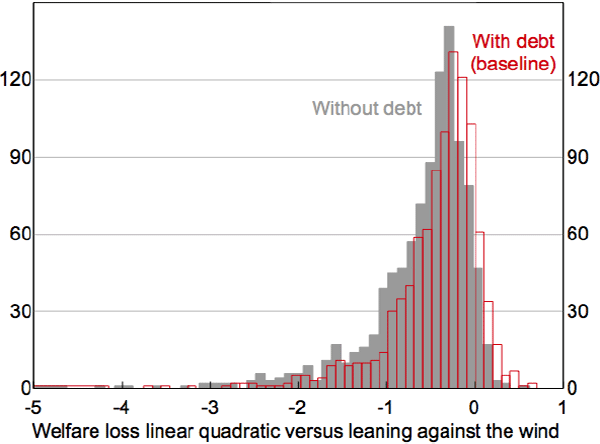RDP 2019-05: Cost-benefit Analysis of Leaning against the Wind 4. Alternative Parameters
July 2019
- Download the Paper 1,513KB
The parameters used in the previous section are subject to uncertainty relating to estimation, specification, data and other sources. Standard errors about many of the parameters are wide when estimated on Australian data, though international estimates tend to be more precise. Other parameters are calibrated, rather than estimated.
Alternative parameters would give different results. For example, we assume that the unemployment rate would increase by 5 percentage points in a financial crisis (relative to the no-leaning-against-the-wind baseline). However, as discussed in Section 3.5, the only Australian experience we have to base this on is the increase in unemployment from 1989 to 1993. If instead, we assumed that the unemployment rate increased by 9 percentage points in a crisis, then the benefits and costs in Figure 3 would be evenly balanced.
International comparisons suggest the results are robust. Similar estimates have been calculated using data for Australia (this paper), Sweden (Svensson 2017a), Canada (Pescatori and Laséen 2016; Gorea et al 2016; Alpanda and Ueberfeldt 2016), the United States (Ajello et al 2016), the euro area (Kockerols and Kok 2019), the United Kingdom (Aikman et al 2018) and international benchmarks (Habermeier et al 2015). Qualitatively different results arise in papers that make unusual methodological assumptions rather than as a result of different parameter estimates. Specifically, Gerdrup et al (2017) argue that debt increases the severity of financial crises, which we discuss in Section 5.2. Gourio et al (2017) assume that a financial crisis leads to a large permanent decline in the level of GDP, which we discuss in Section 6.1. Filardo and Rungcharoenkitkul (2016) emphasise financial cycles, which we discuss in Section 6.3.
The literature explores sensitivity to alternative parameters at length and we do not repeat that discussion. For a summary, Figure 4 shows the distribution of welfare losses estimated by Pescatori and Laséen (2016, Figure 3), drawing from the covariance matrix of their underlying parameters. In almost all of their parameter estimates, leaning against the wind of 25 basis points reduces welfare. Improvements in welfare (bars to the right of zero) ‘reflect a combination of parameters where unemployment and inflation are little affected by monetary policy shocks while the crisis probability is at the highest percentiles of its estimated distribution’ (p 13). The red bars in Figure 4 show this distribution when the probability of a crisis is estimated to depend on the level of, as well as the change in, debt, an issue we discuss in Sections 5 and 6.

Source: Pescatori and Laséen (2016)
Pescatori and Laséen's assessment that unusual parameter values are needed to make leaning against the wind worthwhile is shared by other researchers, including Habermeier et al (2015), Ajello et al (2016) and Svensson (2017a). Adrian and Liang (2018) argue that relatively plausible alternative values are sufficient to change the results, however, Svensson (2017a) responds that the effects they discuss would need to be more than 5 to 40 standard errors larger than existing empirical estimates. Readers looking for extended discussions of sensitivity analysis should consult these papers.
Parameter uncertainty affects the variance about the results, rather than the mean. To change our central result, the estimates need to be biased. Bias is an important concern when the conditions in which the policy would be implemented differ from those in which the parameters are estimated. For example, when the parameters depend on the policy. Accordingly, we emphasise sensitivity along this dimension in Section 5.2.
In practice, sceptics of the cost-benefit comparisons do not seem to base their doubts on alternative parameter estimates. Rather, they are more likely to worry the approach is incomplete or misdirected. For example, Borio (2016, p 2) argues ‘This type of analysis is clearly sound and the findings plausible, but there are a number of reasons why it might underestimate the potential net benefits’. We turn to some of these arguments in the following sections.